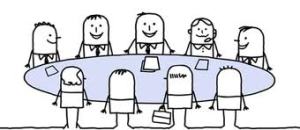 Slavery ended on December 6, 1865 when the 13th Amendment to the Constitution of the United States was ratified. In a nutshell, this means that people cannot own people anymore. I have a hard time juxtaposing this fact with what I hear some non-profit professionals sometimes say, which is: “. . . that is my donor“.
Slavery ended on December 6, 1865 when the 13th Amendment to the Constitution of the United States was ratified. In a nutshell, this means that people cannot own people anymore. I have a hard time juxtaposing this fact with what I hear some non-profit professionals sometimes say, which is: “. . . that is my donor“.
I suspect many of you reading today’s post probably just had a strong reaction to what I said. You’re probably nodding your head and thinking “THOSE” people should know better. However, I suspect many more of us are guilty of trying to control our donors. The following are just a few examples of what I’ve recently seen and inspire this today’s blog post.
Collaborative fundraising
Collaborative fundraising is when two parties get together to raise money for a singular purpose. It could be jointly approaching one large donor (e.g. large multi-national corporation) as a statewide collaborative and asking them to support one program that everyone in the alliance runs. It could also be two separate entities approaching their separate donor lists to support a joint effort.
In my experience, this type of fundraising has become more common in recent years.
You may not be practicing donor-centered fundraising if you find yourself in one of these ventures and you catch yourself saying things like:
- “My list“
- “My donors“
- “My money vs. your money“
Controlling opportunities
 Let’s face it . . . non-profit organizations typically have many competing priorities and projects usually going on simultaneously (e.g. supporting the annual fund, building a new building, renovating an existing space, endowing a program, etc).
Let’s face it . . . non-profit organizations typically have many competing priorities and projects usually going on simultaneously (e.g. supporting the annual fund, building a new building, renovating an existing space, endowing a program, etc).
You may not be practicing donor-centered fundraising if you find yourself doing something like:
- deciding for the donor which project you will won’t present to them as an opportunity because you need their money elsewhere
- steering the donor away from certain projects
- trying to change a donor’s mind when they come to you with an idea
I’m not suggesting that fundraising professionals shouldn’t use their best judgement. You know your donors, and you should know what they are passionate about. So, bringing opportunities that align with their interests and passions is very much donor centered. However, if you find yourself using “organizational needs” as a criteria to decide which funding opportunities are shared with a donor, then you might find yourself in the category of trying to “control donors“.
Donors as Minions movie characters
 I recently saw the Minions in the movie theater. It was in the middle of this relaxing diversion from my crazy work schedule that I came to believe some (perhaps many) non-profit organizations view their donors as these cute, little yellow characters.
I recently saw the Minions in the movie theater. It was in the middle of this relaxing diversion from my crazy work schedule that I came to believe some (perhaps many) non-profit organizations view their donors as these cute, little yellow characters.
- Individually small
- Collectively powerful and useful
- Looking to serve and belong
Of course, if you follow the movie plot line, you quickly realize that Minions are not a mindless drone collective. They have ideas of their own and oftentimes find themselves sideways with the mission. Another common theme throughout this film and the Despicable Me movies is that the villain for whom the Minions work typically ends up failing at controlling this group of adorable yellow characters.
The bottom line for me is that donors are not minions. If you choose to treat them as such, you will likely end up with a big yellow mess on your hands.
What to do about this?
This post obviously leads one to ask the obvious question, which is “what should be done to avoid this behavior?”
I suggest you consider the following simple suggestions:
- Mind your language and try to stop using words like “mine” and “yours“
- Sit down with donors (especially major gift prospects) regularly and engage them in discussions about their philanthropic passions, wishes and dreams
- Develop a “menu of opportunities” for your major gifts initiative
Have you seen or experienced similar situations where donors were being controlled or manipulated? If so, what was the end result? How does your organization share funding opportunities with donors (e.g. menu of major gift opportunties)?
Here’s to your health!
Erik Anderson
Founder & President, The Healthy Non-Profit LLC
www.thehealthynonprofit.com
erik@thehealthynonprofit.com
http://twitter.com/#!/eanderson847
http://www.facebook.com/eanderson847
http://www.linkedin.com/in/erikanderson847

 Last night I met with a non-profit board of directors, and we spent an hour talking about the “Three Stories You Need To Tell“. I centered the discussion around the
Last night I met with a non-profit board of directors, and we spent an hour talking about the “Three Stories You Need To Tell“. I centered the discussion around the  How many times have you been handed pages full of data at the start of any type of planning process (e.g. strategic planning, resource development planning, etc). You are typically asked to look for gaps in addition to organization strengths, weaknesses, opportunities and threats.
How many times have you been handed pages full of data at the start of any type of planning process (e.g. strategic planning, resource development planning, etc). You are typically asked to look for gaps in addition to organization strengths, weaknesses, opportunities and threats. After the assessment phase of any planning process is over, it is common for boards to spend time developing a vision for the future. It is upon this vision that goals, strategies, tactics and metrics are all built.
After the assessment phase of any planning process is over, it is common for boards to spend time developing a vision for the future. It is upon this vision that goals, strategies, tactics and metrics are all built.
 It seems like one common theme in my work with non-profit organizations is that “building consensus” is difficult. Getting everyone on the same page can be like herding cats. It was this reality that had me all tied in knots a few months ago as I was sitting down for the first time with my Philanthropy Day planning committee. We had lots of things to decide (e.g. event location, registration fees, training sessions, discussion panels, etc), and there was very little time to do so.
It seems like one common theme in my work with non-profit organizations is that “building consensus” is difficult. Getting everyone on the same page can be like herding cats. It was this reality that had me all tied in knots a few months ago as I was sitting down for the first time with my Philanthropy Day planning committee. We had lots of things to decide (e.g. event location, registration fees, training sessions, discussion panels, etc), and there was very little time to do so. Last month I sat down with an executive director and two board members to explore how I might be able to help their organization grow their organizational capacity. Over the course of an hour, we talked about all kinds of awesome things such as:
Last month I sat down with an executive director and two board members to explore how I might be able to help their organization grow their organizational capacity. Over the course of an hour, we talked about all kinds of awesome things such as: The people closest to your mission are board and staff members. So, when the organization is short on cash and cannot meet its payroll obligations, it is only natural to ask board members to dig a little deeper.
The people closest to your mission are board and staff members. So, when the organization is short on cash and cannot meet its payroll obligations, it is only natural to ask board members to dig a little deeper. Don’t pass the basket and ask smaller, low capacity donors. Identify your larger, more capable donors and schedule an in-person meeting to explain what has occurred and ask for their support.
Don’t pass the basket and ask smaller, low capacity donors. Identify your larger, more capable donors and schedule an in-person meeting to explain what has occurred and ask for their support. Accounts receivable can be any number of the following individuals/entities:
Accounts receivable can be any number of the following individuals/entities: If your organization finds itself in this mess, then the bank is probably not extending you additional credit. While managing your cash flow on the backs of your vendors is a bad thing to do, sometimes life presents you with a bunch of bad options.
If your organization finds itself in this mess, then the bank is probably not extending you additional credit. While managing your cash flow on the backs of your vendors is a bad thing to do, sometimes life presents you with a bunch of bad options.
![IMG_20150805_111547840_HDR[1]](https://donordreams.files.wordpress.com/2015/08/img_20150805_111547840_hdr1.jpg?w=300)
![IMG_20150805_105024312_HDR[1]](https://donordreams.files.wordpress.com/2015/08/img_20150805_105024312_hdr1.jpg?w=300)
![IMG_20150805_104819757[1]](https://donordreams.files.wordpress.com/2015/08/img_20150805_1048197571.jpg?w=300)
 For those who are curious, here are those 12 steps to a simple and effective face-to-face solicitation:
For those who are curious, here are those 12 steps to a simple and effective face-to-face solicitation: This morning’s video also reminded me of another YouTube video a friend sent me a few days ago. It is a montage of video clips featuring actor Matt Damon in the HBO television series “Entourage“. The YouTube video illustrates the emotions, fears, and mistakes associated with asking your friends and colleagues for a charitable contribution.
This morning’s video also reminded me of another YouTube video a friend sent me a few days ago. It is a montage of video clips featuring actor Matt Damon in the HBO television series “Entourage“. The YouTube video illustrates the emotions, fears, and mistakes associated with asking your friends and colleagues for a charitable contribution.![IMG_20150802_102350339_HDR[1]](https://donordreams.files.wordpress.com/2015/08/img_20150802_102350339_hdr1.jpg?w=300) A few days ago, I was in an airport trying to catch a connecting flight when I saw a poster advertisement for an international non-governmental organization (NGO) that provides medical services to children and families in third world countries. I took a picture of the portion of the advertisement that immediately caught my attention.
A few days ago, I was in an airport trying to catch a connecting flight when I saw a poster advertisement for an international non-governmental organization (NGO) that provides medical services to children and families in third world countries. I took a picture of the portion of the advertisement that immediately caught my attention. One of the clients I’ve been working with for a while is located in Bloomington, Indiana, which is where I met Rachael Jones. Rachael is a transgender woman who used to own “Rachael’s Cafe”. Unfortunately, after eight years of serving coffee, food and a side of acceptance, Rachael closed her doors last month. During my last visit, the executive director handed me a copy of the June 29th edition of The Herald-Times newspaper with a front page story headline that read “Downtown gathering place closes after 8 years of fostering acceptance“. He shared the newspaper story with me because he knew I had wanted to be there for Rachael’s last day, but I just couldn’t make it work with my travel schedule.
One of the clients I’ve been working with for a while is located in Bloomington, Indiana, which is where I met Rachael Jones. Rachael is a transgender woman who used to own “Rachael’s Cafe”. Unfortunately, after eight years of serving coffee, food and a side of acceptance, Rachael closed her doors last month. During my last visit, the executive director handed me a copy of the June 29th edition of The Herald-Times newspaper with a front page story headline that read “Downtown gathering place closes after 8 years of fostering acceptance“. He shared the newspaper story with me because he knew I had wanted to be there for Rachael’s last day, but I just couldn’t make it work with my travel schedule.